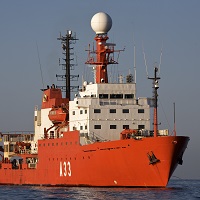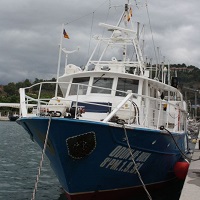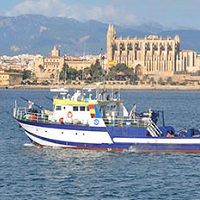Keyword
Strait of Gibraltar
96 record(s)
Type of resources
Categories
Topics
INSPIRE themes
Keywords
Contact for the resource
Provided by
Years
Formats
Status
-

N/A
-

N/A
-

Oceanographic survey collected in the framework of the following research project: INTERCAMBIOS EN EL ESTRECHO DE GIBRALTAR Y SU RESPUESTA A FORZAMIENTOS METEOROLOGICOS Y CLIMATICOS, INGRES 2. This Project is funded by the Education and Science Spanish Ministery.The technical objetive of the mission is to recover and to deploy a mooring system in a monitoring station (Espartel) in the Strait of Gibraltar to estimate the Mediterranean Outflow accurately (ADCP based observations) and the Atlantic Inflow into the Mediterranean Sea, with the help of indirect estimators and incomplete currentmeter data sets.
-

Oceanographic survey collected in the framework of the following research project: INTERCAMBIOS EN EL ESTRECHO DE GIBRALTAR Y SU RESPUESTA A FORZAMIENTOS METEOROLOGICOS Y CLIMATICOS, INGRES 2. This Project is funded by the Education and Science Spanish Ministery.The technical objetive of the mission is to recover and to deploy a mooring system in a monitoring station (Espartel) in the Strait of Gibraltar to estimate the Mediterranean Outflow accurately (ADCP based observations) and the Atlantic Inflow into the Mediterranean Sea, with the help of indirect estimators and incomplete currentmeter data sets
-

Oceanographic survey collected in the framework of the following research project: INTERCAMBIOS EN EL ESTRECHO DE GIBRALTAR Y SU RESPUESTA A FORZAMIENTOS METEOROLOGICOS Y CLIMATICOS, INGRES 2. This Project is funded by the Education and Science Spanish Ministery.The technical objetive of the mission is to recover and to deploy a mooring system in a monitoring station (Espartel) in the Strait of Gibraltar to estimate the Mediterranean Outflow accurately (ADCP based observations) and the Atlantic Inflow into the Mediterranean Sea, with the help of indirect estimators and incomplete currentmeter data sets
-

1.- LEVANTAMIENTO DE LA LINEA DE CINCO CORRENTOMETROS FONDEADA EN EL ESTRECHO DE GIBRALTAR, A UNA PROFUNDIDAD DE 450m\n2.- VOLVES A FONDEAT LA MISMA LINEA EN EL MISMO SITIO\n3.. PERFILES DE CTD PARA LOCALIZACION Y CONTOL DE LAS MASAS DE AGUA QUE ATRAVIESAN EL ESTRECHO
-

Oceanographic survey collected in the framework of the following research project: INTERCAMBIOS EN EL ESTRECHO DE GIBRALTAR Y SU RESPUESTA A FORZAMIENTOS METEOROLOGICOS Y CLIMATICOS, INGRES (REN03-01608/MAR). This Project is funded by the Education and Science Spanish Ministery.The technical objetive of the mission is to recover and to deploy a mooring system in a monitoring station (Espartel) in the Strait of Gibraltar to estimate the Mediterranean Outflow accurately (ADCP based observations) and the Atlantic Inflow into the Mediterranean Sea, with the help of indirect estimators and incomplete currentmeter data sets
-

Oceanographic survey collected in the framework of the following research project: INTERCAMBIOS EN EL ESTRECHO DE GIBRALTAR Y SU RESPUESTA A FORZAMIENTOS METEOROLOGICOS Y CLIMATICOS, INGRES 2. This Project is funded by the Education and Science Spanish Ministery.The technical objetive of the mission is to recover and to deploy a mooring system in a monitoring station (Espartel) in the Strait of Gibraltar to estimate the Mediterranean Outflow accurately (ADCP based observations) and the Atlantic Inflow into the Mediterranean Sea, with the help of indirect estimators and incomplete currentmeter data sets.
-

Obtaining long time series of flows, hydrological properties and other indicators of water mass exchange occurring in the Strait of Gibraltar to contextualize both direct measures of outflow AM as indirect means of AA flow
-

Oceanographic survey collected in the framework of the following research project: INTERCAMBIOS EN EL ESTRECHO DE GIBRALTAR Y SU RESPUESTA A FORZAMIENTOS METEOROLOGICOS Y CLIMATICOS, INGRES 2. This Project is funded by the Education and Science Spanish Ministery.The technical objetive of the mission is to recover and to deploy a mooring system in a monitoring station (Espartel) in the Strait of Gibraltar to estimate the Mediterranean Outflow accurately (ADCP based observations) and the Atlantic Inflow into the Mediterranean Sea, with the help of indirect estimators and incomplete currentmeter data sets
 Catálogo de datos del IEO
Catálogo de datos del IEO